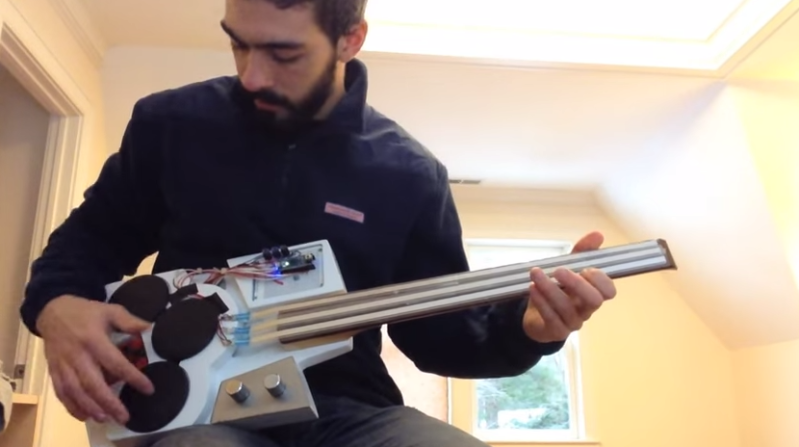[Gr4yhound] has been rocking out on his recently completed synth guitar. The guitar was built mostly from scratch using an Arduino, some harvested drum pads, and some ribbon potentiometers. The video below shows that not only does it sound good, but [Gr4yhound] obviously knows how to play it.
The physical portion of the build consists of two main components. The body of the guitar is made from a chunk of pine that was routed out by [Gr4yhound’s] own home-made CNC. Three circles were routed out to make room for the harvested Yamaha drum pads, some wiring, and a joystick shield. The other main component is the guitar neck. This was actually a Squire Affinity Strat neck with the frets removed.
For the electronics, [Gr4yhound] has released a series of schematics on Imgur. Three SoftPot membrane potentiometers were added to the neck to simulate strings. This setup allows [Gr4yhound] to adjust the finger position after the note has already been started. This results in a sliding sound that you can’t easily emulate on a keyboard. The three drum pads act as touch sensors for each of the three strings. [Gr4yhound] is able to play each string simultaneously, forming harmonies.
The joystick shield allows [Gr4yhound] to add additional effects to the overall sound. In one of his demo videos you can see him using the joystick to add an effect. An Arduino Micro acts as the primary controller and transmits the musical notes as MIDI commands. [Gr4yhound] is using a commercial MIDI to USB converter in order to play the music on a computer. The converter also allows him to power the Arduino via USB, eliminating the need for batteries.
[Thanks Wybren]
















best hackaday ever
Since there’s no strumming involved, how does this differ from a regular keyboard synth?
Slides.
Cool Project!
3 2 1 … commence comments on how this is a Midi Controller and not actually a Synth.
except nobody is calling it a “synth”, they are calling it a “synth guitar” which is no different from calling a midi keyboard a “synth keyboard”
That is true, it’s not generating any sound.
Very cool! I made this thing’s lofi little brother with a DIY softpot made from VHS tape and a guitar string controlling an Atari Punk Console mounted on a scrap of 1×2.
Mine was a noisy wife botherer but this is an instrument! .
Wish he would share his code. I would be very interested how he dealt with those resistance strips.
The YouTube description actually has a github link. Here you go! https://github.com/deanm1278/Arduino-ribbon-synth
laurie anderson was doing this kind of stuff decades ago
This will be my first arduino project. Really impressive, and I wouldn’t be surprised if by the years end this will find its way to major pop bands
I really like your project!
There seems to be a nonlinear pitch selection going on. In other words it’s still a keyboard with the ability to slide but with a zipper effect. I would like to hear him do a delta blues with all the slow bends and off pitch inflections.
Looking at the videos I notice that he is behind the use of servos in tensioning the strings of a guitar as is done in the pedal steel. Like Buddy Emmons. Featured on HaD. This has my attention more than many other musical hacks.
In this heated dry as it can get time of the year I wonder how naked electronics can coexist with clothing and static zaps. A “shield” ie. interface board is definitely not a shield against ESD! Even the buttons and the joyknob are ESD prone.
Very nice all the way around, a truly unique instrument and obviously he enjoys playing it and will probably find many more interesting ways to use it as he plays around with it more, endless possibilities here. I just hope the neck already had the headstock broken off, otherwise kind of a waste of an otherwise “good” neck, but you can pick up beat up squires for less than a new neck I guess.
How come such projects always have horrible noise as sound. Why can’t people make nice sounds with home-made devices? Is it just that the only people trying have some sort of dysfunction? Because it’s getting weird.
“Nice” sounds are for elevators and doctors offices to soothe people who might otherwise be uncomfortable in those environments.
And this is for dentists.for when they get too relaxed at home?
I would like to know how to recognize the flat with Arduino